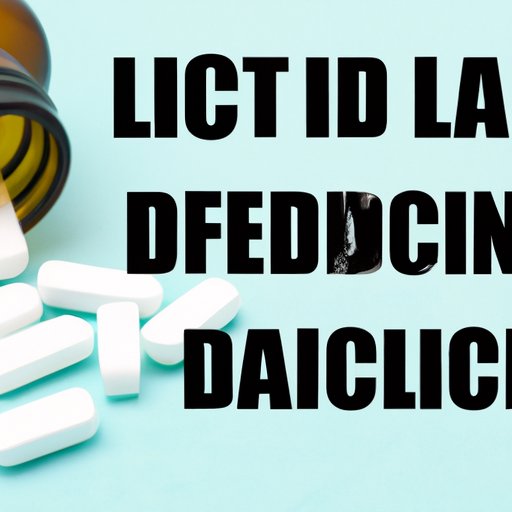Introduction
Lidocaine is a local anesthetic that is used to numb tissues in a specific area of the body. It is most often used as an injection, cream, or ointment and works by temporarily blocking nerve signals in the affected area. The drug is typically used prior to medical procedures such as injections, minor surgeries, and dental work. In this article, we will explore how lidocaine works and discuss its various applications and effects on the body.
Examining the Science of Lidocaine: How Does it Work?
To understand how lidocaine works, it is important to understand its mechanism of action. Lidocaine works by blocking sodium channels in the nerves, which prevents them from sending pain signals to the brain. When the sodium channels are blocked, the nerves cannot send the signal to the brain, thus numbing the affected area.
At a chemical level, lidocaine works by binding to the sodium channels in the nerves and preventing the flow of sodium ions. This inhibits the transmission of electrical signals along the nerve fibers and results in a numbing sensation. Once lidocaine binds to the sodium channels, the nerve cells can no longer send electrical signals to the brain, thus providing relief from pain.
Lidocaine comes in several forms, including topical creams, gels, ointments, and injectable solutions. Each form has different properties and effects on the body. For example, topical forms of lidocaine are generally less potent than injectable forms, but they can still be effective for relieving pain. On the other hand, injectable forms of lidocaine are more powerful and can provide faster relief from pain.

An Overview of Lidocaine: Exploring Its Uses and Effects
Lidocaine is most commonly used as a local anesthetic prior to medical procedures. It can also be used to relieve pain associated with conditions such as shingles, burns, and insect bites. Additionally, lidocaine is sometimes used to treat arrhythmia, or abnormal heart rhythms.
Though lidocaine is generally safe when used properly, there are some potential side effects associated with its use. These include dizziness, drowsiness, confusion, blurred vision, nausea, and vomiting. It is important to talk to your doctor if you experience any of these side effects after using lidocaine.

The Benefits of Lidocaine: A Closer Look at Its Functionality
Lidocaine is an effective anesthetic that has numerous benefits. Here are some of the most notable:
Pain Relief
One of the primary uses of lidocaine is pain relief. By blocking nerve signals, lidocaine can help reduce discomfort associated with medical procedures and certain conditions. According to a study published in the Journal of Clinical Anesthesia, lidocaine is “an effective analgesic agent in many clinical settings” (Journal of Clinical Anesthesia, 2019).
Prevention of Infection
In addition to providing pain relief, lidocaine can also help prevent infection in the affected area. By numbing the area, lidocaine can help reduce the risk of infection, as bacteria and other pathogens are less likely to enter the wound.
Numbing Sensations
Lidocaine can also be used to numb sensations in the affected area, such as itching or burning. This can be especially helpful for people who have sensitive skin or are prone to irritation.
Understanding the Chemistry Behind Lidocaine: What Makes it Effective?
The effectiveness of lidocaine is due to its unique chemical structure. Lidocaine is composed of a benzene ring, two amide groups, and one nitrogen atom. This combination of atoms allows lidocaine to bind to sodium channels in the nerves and block the transmission of electrical signals.
The bonding structure between lidocaine and the sodium channels is key to understanding how lidocaine works. The nitrogen atom in lidocaine forms a hydrogen bond with the oxygen atom in the sodium channel, which blocks the transmission of electrical signals. This interaction is what makes lidocaine so effective at numbing the affected area.
A Comprehensive Guide to the Mechanism of Action of Lidocaine
Now that we have explored the chemistry behind lidocaine, let’s take a closer look at how it actually works.
How Lidocaine Blocks Nerve Signals
Lidocaine works by blocking sodium channels in the nerves, which prevents them from sending pain signals to the brain. When the sodium channels are blocked, the nerves cannot send the signal to the brain, thus numbing the affected area.
The Role of Sodium Channels in Nerve Activation
Sodium channels are essential for nerve activation. They allow sodium ions to flow through the nerve cell membrane, which creates an electrical signal that can be sent to the brain. When lidocaine binds to the sodium channels, it prevents the flow of sodium ions, thus inhibiting the transmission of electrical signals.
How Lidocaine Prevents Neural Transmission
Once lidocaine binds to the sodium channels, the nerve cells can no longer send electrical signals to the brain, thus providing relief from pain. This process is known as neural inhibition, and it is the primary mechanism of action of lidocaine.

Debunking Common Myths About Lidocaine: How It Really Works
Despite its widespread use, there are still some misconceptions about lidocaine and how it works. Let’s take a look at some of the most common myths surrounding lidocaine and dispel them once and for all.
Misconceptions About Lidocaine
One of the most common myths about lidocaine is that it only works on the surface of the skin. In reality, lidocaine is effective at numbing deep tissues as well. Another myth is that lidocaine causes permanent nerve damage. While lidocaine can cause temporary nerve damage, it does not cause permanent damage.
Dispelling Myths About Lidocaine
It’s important to remember that lidocaine is a safe and effective anesthetic when used properly. It is not dangerous or harmful when used according to directions. Additionally, lidocaine does not cause permanent nerve damage; rather, it simply blocks the transmission of electrical signals, resulting in a numbing sensation.
Conclusion
In conclusion, lidocaine is a safe and effective anesthetic that can be used to numb tissues in a specific area of the body. It works by blocking sodium channels in the nerves, which prevents them from sending pain signals to the brain. Additionally, lidocaine can be used to prevent infection, numb sensations, and provide relief from pain. Understanding the chemistry behind lidocaine and its mechanism of action is key to understanding how it works.
By dispelling some of the common myths surrounding lidocaine, we can gain a better understanding of how it really works. With this knowledge, we can make informed decisions about whether or not to use lidocaine and ensure that it is being used safely and effectively.
We hope this article has helped you gain a better understanding of lidocaine and its mechanism of action. Now that you know how lidocaine works, you can make more informed decisions about its use.
(Note: Is this article not meeting your expectations? Do you have knowledge or insights to share? Unlock new opportunities and expand your reach by joining our authors team. Click Registration to join us and share your expertise with our readers.)
